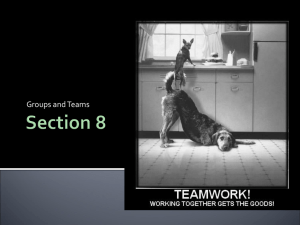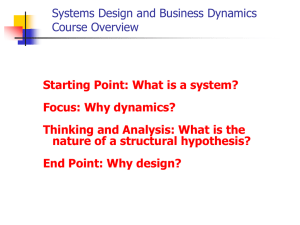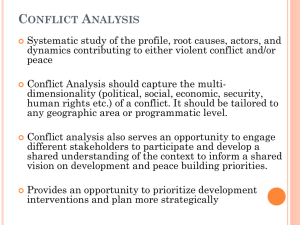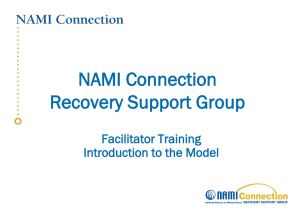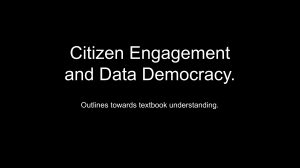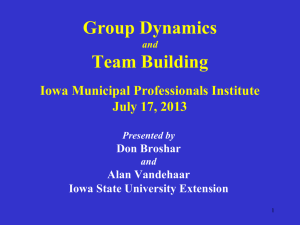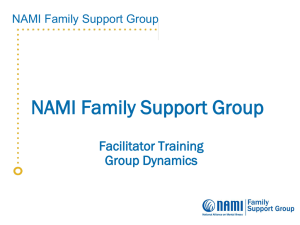Group Dynamics
advertisement
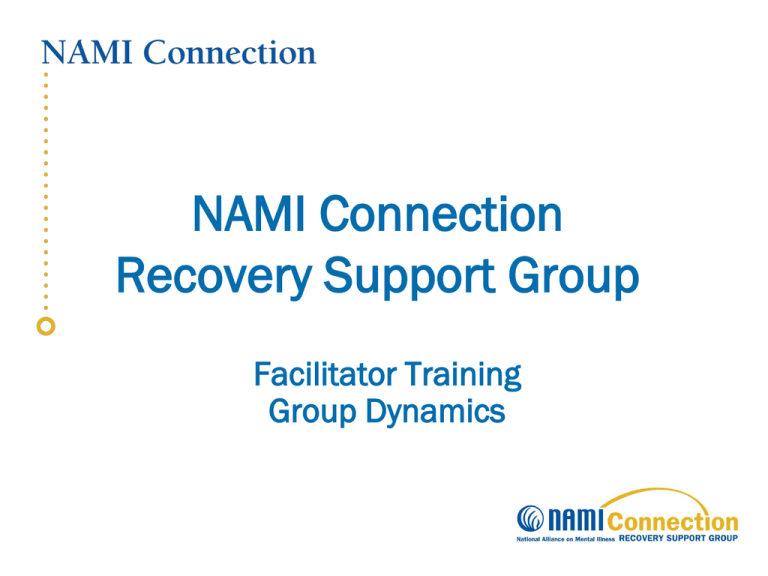
NAMI Connection Recovery Support Group Facilitator Training Group Dynamics Why Do We Need A Model? • to help navigate around the predictable negative group dynamics which can torpedo a successful group process • a support group can operate much like a personality with a will of its own, and that collective group willfulness can pull even the most experienced facilitator off course Group Dynamics What is a group? Two or more people interacting with each other 2= Dyad 3= Trio 10-15 = Work Group 20-500 = Audience 200-1000 = Crowd Group Dynamics • NAMI Connection groups are peer working groups of 10-15 people • Support groups should be maintained at this size What are Group Dynamics? • Groups act and react as individuals do • Groups have many of the same dynamic (interactive) problems as individuals • If you understand how individuals react in certain circumstances, you can explain problems that arise in groups. Dynamic issues that concern groups • Leadership • Boundaries • Rules • Goals • Subject Matter Problems caused by negative group dynamics in support groups Problems in group dynamics • Related to leadership • Related to group boundaries • Related to observing group rules • Related to group goals • Related to our specific group subject – mental illness Problems related to Leadership Problems related to Group Boundaries Problems related to Observing Group Rules Problems related to Group Goals Problems related to the Group Subject – Mental Illness What is the remedy for these problems? • A Capable Leader • Clear Boundaries • Stating and Enforcing Rules of Relationship • Clarifying Goals and Purposes • Identifying the “Common Cause” in a Positive and Optimistic Manner Problem Dynamics • Challenges to leadership • Negative group dynamics start to rule Why do people go to a Support Group? To leave feeling better than when they came To feel that they contributed as well as they were supported To feel in a very real way that they have something in common with others. What do they want at a Support Group? • A safe place • To not be judged • Boundaries that are enforced • Capable Facilitators Encouraging a group to do its own work You are present to help the group meet its needs, not to have the group help you meet yours A well-functioning Support Group • Has a skilled Facilitator • Does its own work • Involves as many group members as possible • Encourages self-enforced observation of behavior guidelines A well-functioning support group • Allows group members to feel they have contributed • Provides strategies • Connects participants to resources and services • Makes members feel they have benefited from attending NAMI Connection Strategies, Structures and Group Processes The model that ensures an effective support group meeting What Facilitators need to know • To recognize problems in group dynamics – there are cues that the Facilitator needs to transition the group • Know what structure or group process to use to remedy the problem • Have the skills to shift the group from where they are to where they need to go Cues and Remedies • Each Structure and Group Process exists to remedy a particular set of negative dynamics that commonly occur in support groups. • Strategies help to shift the group smoothly and naturally Identifying negative dynamics (cues) and possible remedies (structure or process) Dynamics and Remedies When you hear this Cue: • Someone taking too long during Check In Move to this Structure: Agenda • 1-2 minute time limit for Check In When you hear this Cue: • A “downer” meeting needs to be closed on a positive note Move to this Structure: Agenda • Closing When you hear this Cue: • People can’t stay in the present Move to this Structure: Group Guidelines • Keep it in the here and now When you hear this Cue: • Someone or the group is negative or hopeless Move to this Structure: Principles of Support A principle can represent something we can all strive for When you hear this Cue: Someone expresses intense feelings (emotional stage reactions of feeling overwhelmed, anger, grief) Move to this Structure: Emotional Stages Chart • Acknowledge that strong emotions fall within the predictable stages of emotional response When you hear this Cue: • Someone relates a traumatic event (violence, commitment, arrest, restraint, or traumatic loss) Move to this Process: Hot Potatoes A step by step way to address traumatic events and close the discussion of the trauma on a positive note When you hear this Cue: A basic issue or question can be clarified by the group Move to this Process: Group Wisdom Provide basic information or helpful and constructive ideas to a group member, share coping suggestions When you hear this Cue: A discouraged person needs new options to solve a long-standing problem Move to this Process: Problem Solving Moves person away from what doesn’t work by offering new/different options to approach their problem NAMI Connection Facilitators • “Take charge” when shifting the group and then step back to let the group do its own work • Shouldn’t sound or act like therapists • Provide a safe, nurturing place What is the PRIMARY DANGER for facilitators of a structured support group model? Not using the model Structures and Processes Remember, as a capable Facilitator: You are present to help the group meet its needs, not have the group help you meet yours.

